Back to the future
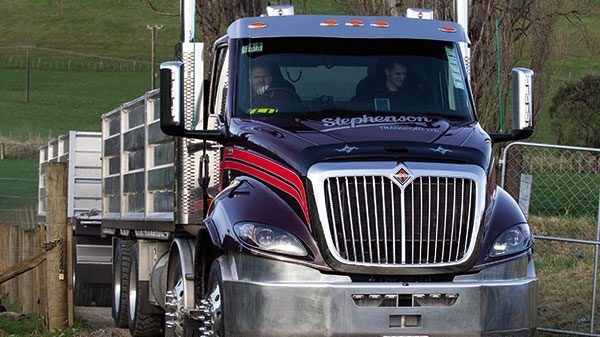
The International RH picks up where its ProStar predecessor left off – a lightweight short-bonnet conventional, packing some serious punch. Our first taste would come with RH No.1, which found something of an unlikely home in rural cartage. But if there’s one company that can prove its merits, it’s Waipawa’s Stephenson Transport.
It’s been a good couple of years for new-truck buyers in New Zealand. Whether your flavour is Eastern, Euro or American, the menu of new – or, at the very least, updated – models released in the past 12 months has been enticing.
Home-grown entity Intertruck has been hard at work, too, developing its bonneted International ProStar range through its next evolution – the RH. Visually, there may not be many standout features to differentiate it from a familiar face. The ProStar’s introduction into its home market took place as long ago as 2006, while Intertruck has offered it in New Zealand since 2017. Continual improvement while maintaining a level of familiarity is by no means a bad thing, which is what the shift to RH represents. And, besides, beauty is more than skin deep; the biggest enhancements are the ones you can’t see.
Our first taste of RH follows something of a coup for Intertruck. Hawke’s Bay- based Stephenson Transport has put four of the OEM’s cabover 9870s to work in its stock division, but the RH is the first to combine an International badge with a tipping dropside setup. It’s also the first bonneted truck to enter the fleet in a long, long time – in rural cartage too, where things like bonnets have the potential to complicate proceedings. So there’s a little something to prove. It would be a telling couple of days with driver Ian ‘Nunga’ Allhusen.
In the Stephenson fleet, the RH picks up the bonneted baton from trucks truly of another generation… 2023 is the company’s 87th year in business, and its association with International goes back to the earliest days, when Septimus James Edward and Mary Stephenson started the business in 1936 with a Morris Commercial, followed progressively by five Internationals.
To be fair, the RH and 9870 are a far cry from the D Series models of the 1930s and 1940s, the Acco 180 Butterbox that joined the fleet in 1963, and the T-Lines of the 1980s. All of these were dutiful earners for this family business that today has its fourth generation behind the wheel.
Back to the bay
This is our second trip to Hawke’s Bay in as many road tests, though we’d really only popped in with Colin and the TGX last month. Granted, you didn’t have to go much further than Bay View to see the chaos wrought by a very wet first half of the year. The unassuming Central Hawke’s Bay town of Waipawa was not immune to the flooding following Gabrielle. And although the back of Stephenson’s Ruataniwha Street yard lies low, just up the bank of the Waipawa River, the company luckily came out unscathed.
CEO Todd Stephenson recalls the events of early February: “Warnings were in place, so we’d put off a lot of work – which we didn’t do even through Covid. Some of the trucks were out of town, and they were told to camp over. We turned up in the morning, and the power was off, so I told everyone to go home and operate from our cell phones.
“Dad [Bruce] was the only one here. For whatever reason, he walked out and looked over the bank, down at the yard, and there was our smallest truck with water above the rims. He rang me straight away and said: ‘Where is everyone? The bloody yard’s flooding!’
“I said, ‘Bullshit, it hasn’t rained for three hours!’ But it had been coming down heavy in the ranges. I raced back to work with my youngest. We grabbed handfuls of keys off the keyboard, I threw my boots and socks off and rolled my jeans up – man, it was deeper than I’d ever seen it. At that stage, it still wasn’t raining, and the water hadn’t even come over the river bank yet, but it was bubbling up through the ground.
“I tilted the cab on the little truck to see if the fan and intake were submerged. I thought, ‘All we have to do is get it up the highest part of the yard.’ I said to my young fella, ‘I’ll start them, get them to here, and you whip them up to the street.’ As it was, all the smaller trucks were parked at the deepest part of the yard,” Todd continues.
“Then the river burst its bank and gradually blew the fences out. You couldn’t see the trailer drawbars to see whether or not they were connected to their trucks. The last few trucks were driven out with their diff locks in and in crawler gear while their trailer brakes were still releasing. It was about 20 minutes from when I arrived to getting the last of 27 trucks out.”
Evidently, our date with the RH might not have happened. “Nunga, he took his keys home! So, the newest truck was one of the last to come out! But we got them all out,” Todd recalls.
Two or three of the Isuzus ended up with a little water in the oil and oil pressure lights on, though an immediate oil change rectified that, and they’ve been fine since, says Todd. Saving the trucks was the big focus – nine trailers were left behind and had to have their brakes cleaned out and wheel bearings repacked.
“Shit, the current was swift. A four-axle stock trailer moved 50m across the yard. It got swept out by the current. But, luckily, the dolly turned and anchored itself, moving the trailer off the current,” Todd says. “We had to open the crate doors to allow the water to flow through them and stop them moving with the force of the water. It was deep… I had to put my head under a few times to open the latches.”
The chaos didn’t stop there, though. As it was hay season, all the drop siders had their sides off, which also needed to be rescued. “A chap in a little boat came to help. We did one rescue of sides, but then the boat ran out of petrol. We were sitting out there for a good hour until another guy arrived with a jet boat and towed us back.
“You wouldn’t imagine that would ever happen. Just the other week, we had some big downpours and three nights in a row, we parked the gear up here… Everyone’s a bit paranoid.”
It is a chilling story and a poignant reminder of the power of Mother Nature.
Working in stock transport, Stephenson was instrumental in safekeeping local farm stock. “Most of the farmers were getting bloody anxious, as you can imagine,” Todd says. “We had to get MPI onboard for stock recovery to get into some of the affected areas. A lot of our roads were a mess, but we knew we could get in, so long as bridges weren’t out. We had to persuade them that this is what we do for a living – just let us get in and move it.”
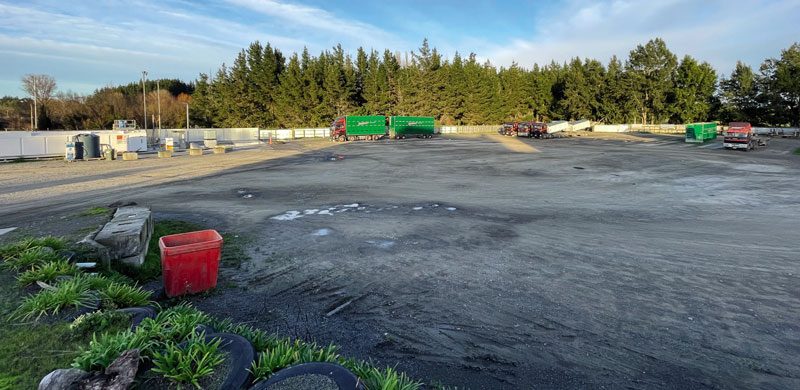

The International among brands
Anyone who knows the Stephensons understands that this knuckle-down-and-do attitude is ingrained. Doing what needs to be done is in the DNA and goes back to the foundation set by Septimus Stephenson. “Bruce and Todd are the most straight up and down guys you’ll ever come across – real good rural Hawke’s Bay people. Just fantastic, easy people to deal with,” says Hugh Green, Intertruck national sales manager.
Hugh’s relationship with Stephenson goes back to the 2010s, and the International brand has slowly re-established itself at Waipawa. “I think their trust in what we’re doing has come through pretty loud and clear now,” Hugh says. “We’re deep into a replacement programme [of older units] with the 9870s.”
And, in the context of Stephenson Transport, we can’t talk RH and ignore 9870. So far, four 9870s are on the road in the stock division, with No.5 at the bodybuilder and No.6 currently on the Intertruck production line. Todd says that by all accounts, the Inters are holding their own among the fleet’s Argosys, K200s, DAFs and Isuzus.
“One day, Hugh came here with a 9870. The chassis work is tidy on them, simple. And the four-airbag system on the back end we find is far better for traction and stability – we already knew that from the Argosys,” Todd says.
Much like the K200s, the decision over the 9870s was as much about performance, dependability and support as it was about attracting the right drivers. It’s becoming a topic for the ages. “We got to the stage we were struggling to get drivers across. Young ones like the American gear – they’re big, bulky, with plenty of room to sleep in.
“But importantly, the American gear has the axle spacing; right up on the bumper, and you don’t have to go super long with the trailer to reach 50MAX.
The key for us is to have all the trucks capable for the same backloads. We try keep them all pretty much the same [spec and setup] regardless of the make.”
The arrival of the RH into the dropsider fleet was therefore met with some questions. The bonnet was the most obvious – tight rural accessways and farm gates, impacted visibility, shorter bins… all were concerns that needed answering.
“There was always a concern how we’d get on with access with the bonnet. That’s a fairly expensive bumper, I wouldn’t want to replace that in a hurry…” Todd quips. “But we used to have N10/N12 Volvos back in the day and we got on all right with those. The visibility of the RH bonnet slope is awesome – I wouldn’t want to try to look over a 909 in our application, as much as the drivers would love to,” he says with a laugh.
Otherwise, The RH is pretty much a standard spec for a Stephenson dropsider. The bonnet means the deck is 500mm shorter, at 6500mm, but being a day cab helps. The RH is the only truck in the fleet without a sleeper, though the dropsiders return to base each night, so that becomes a moot point beyond the length debate.
While the RH continues the ProStar’s unique selling point of ultimate tare weight, achieving those figures comes down as much to the deck and trailer fit out by Pahiatua’s Jackson Enterprises. “It’s a complete Jackson build; they pretty much do all our work and have done for years,” Todd says.
Easy going
The timing being what it was, we met up with Nunga and the RH right in the middle of the rainy season, when the RH’s primary role – fert work – had slowed right down. That means we’d mainly be tipping gravel, with the bonus job of shifting some hay bales on a particularly gorgeous sunny Hawke’s Bay morning before parting ways.
The first job out of the despatch office is to shift a load for HES Quarries from Back Paddock Lakes to its yard at Irongate Road, Hastings. Next stop, Hutts Quarry, Tikokino, on SH50, for a load to Doug Brightwell’s Tikokino Contractors, a stone’s throw from Stephenson’s outside Waipawa – so to speak. While there, we load up the first of three 14-tonne, truck-only loads destined for a private driveway on Porangahau Road.
So far so normal, and being all local and partly truck-only, there’s not much to challenge the RH. What is immediately noticeable, though, is Nunga’s approach to his work. Having driven all kinds of trucks and moved all kinds of commodities, Nunga is most at home on dropsider work. The RH is equipped with a Base Engineering remote, which combines all tipping controls in a handy, portable unit. Nunga admits he wasn’t too keen on it at first, but with a bit of use, he’s found it to be more accurate for spreading and convenient for tipping when he has to get out and check the bin height.
Handy remote or not, to watch the man spread gravel is to witness a masterclass in precision. “You might want to stand just the other side of that oak tree, the gravel will stop just there,” he says before setting off down the drive. True to his word, the nose of the RH glides past the tree before the last stone falls from the tailgate in line with the mighty oak.
As you’ll read in Like father like son, Todd would later tell us that Nunga is particularly proud of being neat and precise whether loading or unloading. It’s not often we witness a driver peering into the bins directing the loader!
Our next load from Hutt’s Quarry to Doug’s yard is a full 30-tonne and includes a quick jaunt down SH50 to Maraekakaho and back. Fortuitously, this allows us to stretch the RH’s legs along some of the typical, narrow, windy, undulating rural Hawke’s Bay roads on which it’ll spend much of its time, with the odd climb thrown in for good measure.
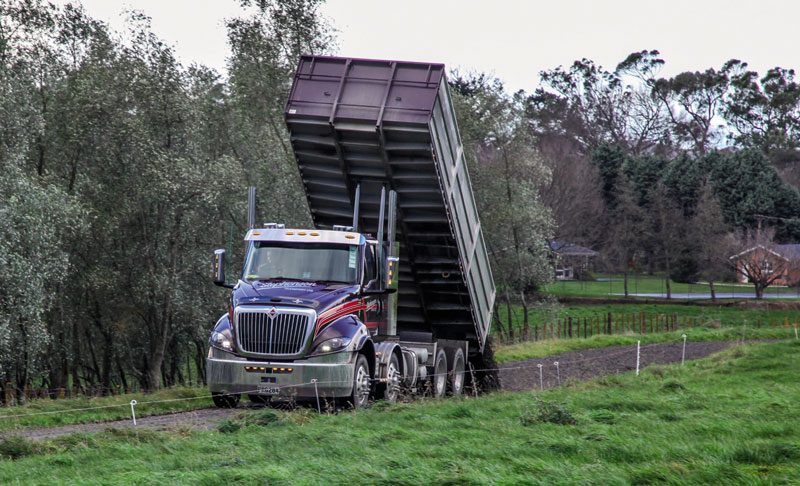
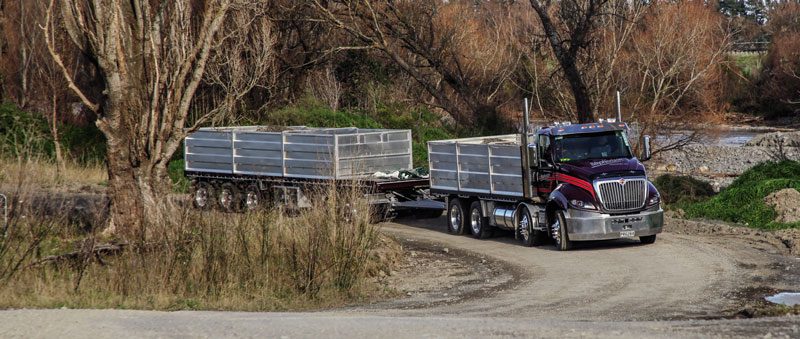

Straight away, it’s as though we’re back in the cab with the Central Log Transport team (New Zealand Trucking, May 2021) and Brian Aitchison from MMM Cartage (New Zealand Trucking, June 2019). Like its ProStar predecessor, the RH moves down the road with a sporty edge. Nunga is a master at imperceptible gearshifts, conducting the Roadranger to keep the X-15 at its maximum 2779Nm (2050lb/ft) torque band between 1100 and 1600rpm. Rarely does he stretch it to the maximum power peak of 459kW (615hp) at 1800rpm.
Having driven less than 30,000km, the X-15 is just getting into its stride. But its low-down torque delivery is strong – pulling cleanly to crest a not insignificant hill down to as low as 1000rpm. On one of the gnarlier climbs, Nunga keeps it on the boil in seventh high at 1500rpm, maintaining a steady 40km/h. Fuel efficiency currently sits at 2.2km/L.
As with its predecessor, the RH emits a hard-edged growl from its twin stacks as the revs push past 1500rpm. Under load, we measured 74 to 76db in the cab, which settles down to a respectable 70 to 72db on the cruise. Nunga comments: “You can get a bit sick of it some days – it can get a bit droney. Coming off the DAFs and Isuzus, it’s just a bit different. I think the last real noisy truck I drove was an old 430hp V8 Mitsi when I was at Farmers Transport; a good truck, comfortable, go-anywhere, just noisy.
“But I can’t complain about the power and comfort in this. It’s good to have the stronger motor, especially considering this is the first five-axle dropsider we’ve got. And the Jake is strong, and it sits on the road well. I’m loving the truck,” he says.
As we became accustomed to with the ProStars, off-road traction in the RH is exemplary. Todd would explain that the decision was made to forego CTI and see how the RH gets on, as Trevor was confident he could build it with the weight in the right places for maximum traction. Then, when off the power and on the open road, it settles into a comfortable cruise. The ride is at least as good as we remember it, with no hint that there’s a second steer axle just behind your bum.
Dropping sides
Visibility was another strength of the ProStar. That has only been improved in the RH thanks to its deeper one-piece side windows and single-arm mirror mounts, which position the large mirror units further out, improving side and rear visibility.
“The visibility is good out the front and right back through the large mirrors. But there is a slight blind spot out left where the mirror housing can get in the way,” Nunga comments.
They do look good though.
It can be disappointing to put a dropsider through its paces and not actually get an opportunity to drop the sides. Fortunately, Darren Cooper Agriculture of Otane needed 36 big rounds of hay delivered from Donald Cooper’s (no relation) farm on Homewood Road, Waipawa, to Oakland Stable Charf on Railway Road, Pakipaki.
“I must admit, Jacksons does do a good trailer. They did the deck, guards and toolboxes as well,” Nunga says. Indeed, truck deck and trailer are as neatly executed as they come.
The trailer is underpinned by ROR axles, a favourite of Stephenson’s when spec’ing a unit to ride on 19.5s.
While Nunga guides Darren’s placement of the hay, we jump aboard the RH to take in its interior. Intertruck bills the RH as a low-entry conventional, and with just two wide steps before climbing into the cab, there are no complaints other than only the driver’s side having an A-pillar grab handle. As a day cab, space is fine; Nunga has more than enough room in the Isringhausen driver’s seat behind the multi-adjustable wheel.
The cab’s slate-grey diamond vinyl trim is paired with a new dark-grey dashboard trim. Compared with the old, almost-beige light grey, it goes some way to modernising the feel of the interior. The new door trims are a big improvement, with the handle moved up to the windowsill for easier reach and a larger pocket with a bottle holder lower down. More storage can be found in the RH’s centre storage console between seats and under the dash wrap. There are a couple of trays overhead and a handy little cubby under the passenger seat.
For now, the layout remains much the same as the ProStar (see Building an RH), with the familiar 10-gauge cluster supplemented by three gauges out to the left with space for auxiliary switches below. The trailer brake is now a T-handle in the centre console – whether that’s more practical than the old column stalk will be down to driver preference. At least it doesn’t get in the way of the HVAC controls. Switches for the cruise remain on the two-spoke wheel with just a single wand on the left for indicators, high beams and wipers. Suffice to say, anyone who’s ever piloted at ProStar will be right at home and slightly more comfortable in the RH.
Different strokes
A company like Stephensons would have seen a lot during nine decades in business. Through it all, it’s remained true to its purpose as a rural carrier – in a world where the word ‘holiday’ barely exists and hard work, determination and personal relations are the only drivers of success.
That’s meant keeping up the status quo when things are sailing along just fine and not being afraid to change things up a little when needed. When you think about it, there’s something almost romantic about the reintroduction of International to the fleet over the past few years.
While the 9870s have proved perfectly up to the task of livestock transport, it would be fair to say that in its application, the RH has weightier expectations. It’s filling the boots of trucks that are traditionally better suited to the role purely by way of their configuration. However, as a conventional, it hasn’t come unstuck yet. Visibility and manoeuvrability have been top-drawer despite the bonnet, with no need for tight emergency U-turns in Nunga’s day-to-day rovings as yet.
The X-15 under that stubby bonnet raises it above its dropsider stablemates, too. And, as Todd puts it, there aren’t many options for this application in the +600hp, H-plated realm.
“As far as a dropside or bulk truck goes, I rate the RH. I wouldn’t have any problems buying another when it’s time to replace the Isuzus, and really, what options have we got? There’s not much by way of cabovers unless we go Japanese, and if you want the horsepower, it probably would be one [RH] over a European.”
Having spent a few days in the company of this RH, we’re excited to get to grips with one in perhaps a more traditional application – and even more to see how Intertruck keeps up the model’s development.
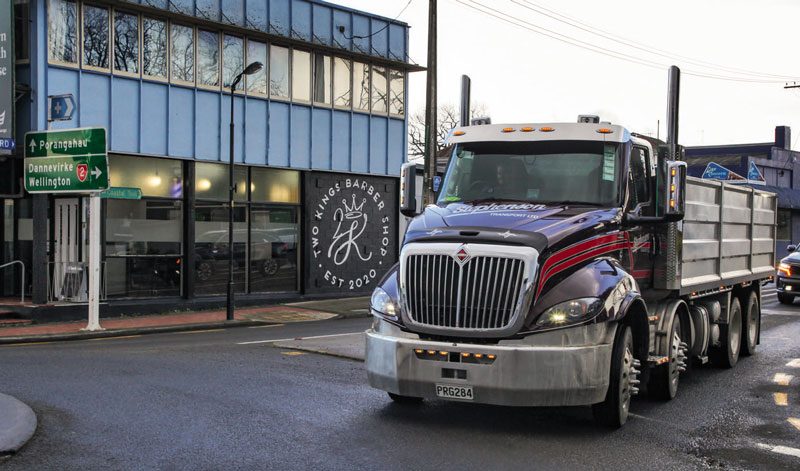
Special thanks
Bruce and Todd Stephenson – possibly the nicest, most obliging father-and-son duo in New Zealand road transport – thanks as ever for allowing us into your operation and affording us the time with your newest addition.
To Nunga – what a character, a driver of the old school who holds no punches. Thanks for having us along and chaperoning us for a couple or three days. Thanks also to Doug Brightwell for access to your yard (and the awesome memorabilia we were allowed to pinch) and Darren Cooper for access to the farm.
And Comer Board and Hugh Green at Intertruck – once again proving that Kiwi engineering can keep up with the best of ‘em. Thanks for the insight into the RH’s development.

Quick reads from Tests
Read more
The right man for the job
0 Comments29 Minutes
Legendary ambition
0 Comments36 Minutes
Hard Fought!
0 Comments40 Minutes
Postal Trifecta
0 Comments29 Minutes

































